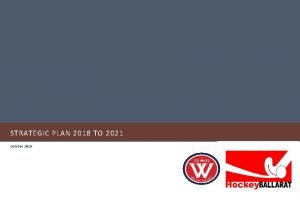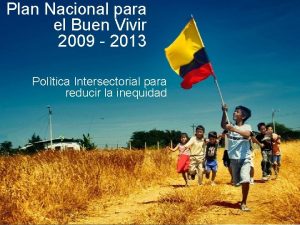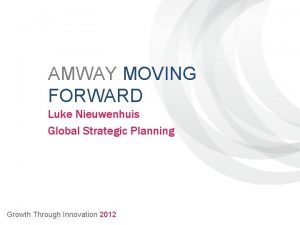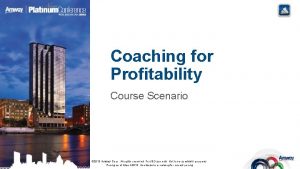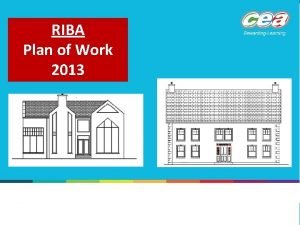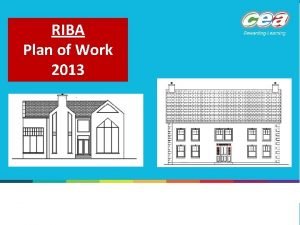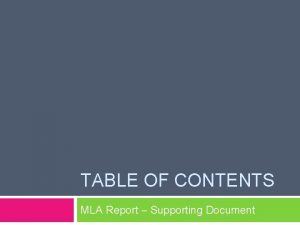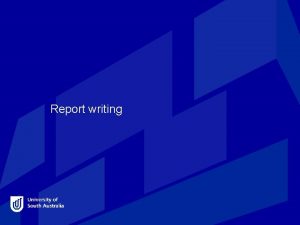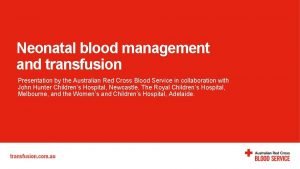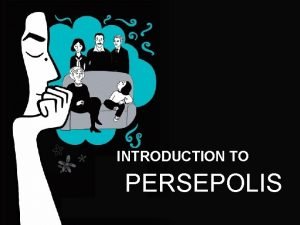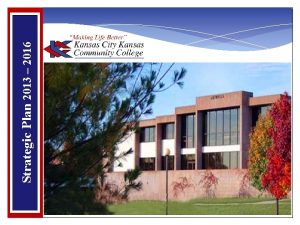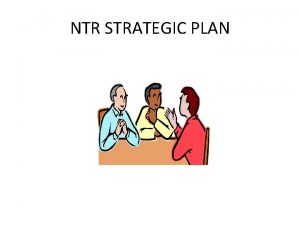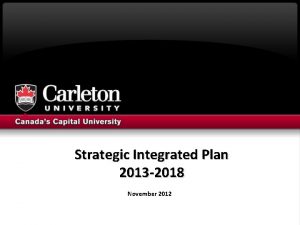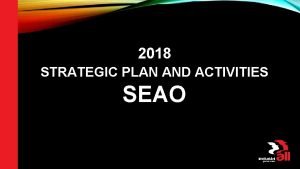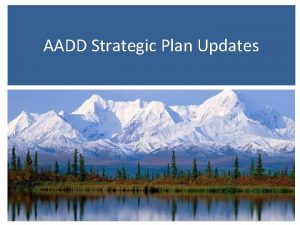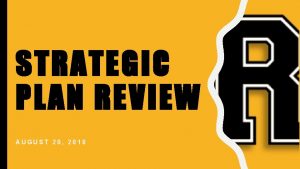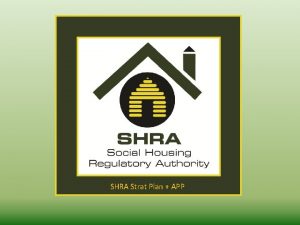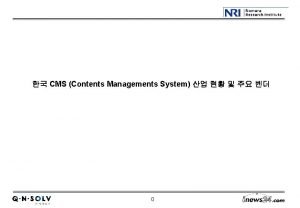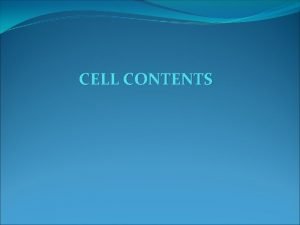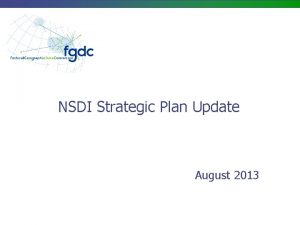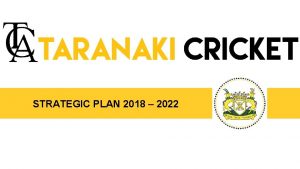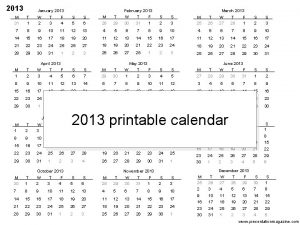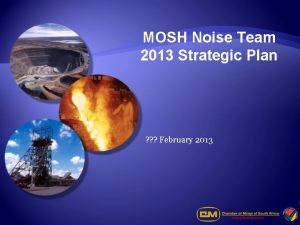STRATEGIC PLAN 2013 2018 CONTENTS 1 STRATEGIC PLAN


































- Slides: 34

STRATEGIC PLAN 2013 - 2018

CONTENTS 1. STRATEGIC PLAN 1 -18 2. ANNUAL PLAN 19 -28

PART A: STRATEGIC OVERVIEW VISION To be an independent world class regulatory authority on nuclear safety MISSION STATEMENT To provide and maintain an effective and efficient national regulatory framework for the protection of persons, property and the environment against nuclear damage 3

PART A: STRATEGIC OVERVIEW VALUES Value Description Professionalism We hold ourselves accountable to the highest standards of professionalism in everything we do Integrity We demonstrate integrity and ethical conduct in all we do Excellence We strive for excellence in all we do Valuing People We demonstrate that we value our people in all we do Team Work We demonstrate a team working approach across the NNR Openness and transparency We demonstrate openness and transparency in our 4 interactions with all

NNR LEGISLATIVE MANDATES 1. Provide for the protection of persons, property and the environment against nuclear damage through the establishment of safety standards and regulatory practices; 2. Exercise regulatory control related to safety over the sitting, design, construction, operation, manufacture of component parts, and decontamination, decommissioning and closure of nuclear installations; 3. Exercise regulatory control over other actions, to which this Act applies, through the granting of nuclear authorisations; 4. Provide assurance of compliance with the conditions of nuclear authorisations through the implementation of a system of compliance inspections; 5. Fulfil national obligations in respect of international legal instruments concerning nuclear safety; 6. Ensure that provisions for nuclear emergency planning are in place.

KEY ENACTED FUNCTIONS OF THE REGULATOR 1. Grant or amend nuclear authorisations; 2. Employ assets and deploy resources (hire, purchase, acquire); 3. Collaborate with other institutions for the collection and dissemination of scientific and technical information regarding nuclear energy; Collaborate with other institutions regarding provision of instruction for or training of persons required by the NNR; 4. 5. Provide financial and other assistance for the training of people to enable the NNR to perform its functions; 6 Insure itself against loss, damage, risk or liability; 7. Advise the Minister on: a. Conditions that may cause nuclear damage b. Items the Minister has referred to the NNR c. What the NNR thinks necessary; 8. 9. Act as national competent Authority in connection with International Atomic Energy Agency’s Regulations; Conclude contracts to enhance the value of the services rendered by the NNR; 10. Prepare & submit annual report on the health & safety of workers, the public and environment associated with all sites.

GOVERNMENT PRIORITY PLANS The diagrammatic presentation below indicates links that the NNR has with other Government priorities and plans. Key amongst government plans that NNR has considered in its strategic planning process are: PERFORMANCE EVALUATION FRAMEWORK THE NEW GROWTH PATH INDUSTRIAL POLICY ACTION PATH 1. PROMOTING SOCIAL COMPACTS BETWEEN AUTHORISATION HOLDERS AND THE COMMUNITIES IN WHICH THEY OPERATE 2. INCREASING THE RATE OF INVESTMENT IN FIXED ASSESTS PARTICULARLY INFRASTRUCTURE CAPACITY I. E. OFFICES , TECHNOLOGIES, SKILLS AND EXPERTISE TO SUPPORT THE GROWTH PROCESS 3. ADVANCING THE TRANSFORMATION AGENDA THROUGH CAPACITATING & EMPLOYING NEW YOUNG NUCLEAR SCIENTISTS AND ENGINEERS FROM PREVIOUSLY DISAVANTAGED GROUPS 4. OPTIMISING INTERNATIONAL AND GLOBAL INDUSTRY TRENDS TO ACHIEVE GOVERNMENT’S VISION OF BEING A RESPONSIBLE GLOBAL CITIZEN

THE PERFORMANCE EVALUATION FRAMEWORK AND OUTCOMES APPROACH OF THE 12 OUTCOMES, THE NNR IS DIRECTLY MANDATED AND HAS ADOPTED A STRATEGY THAT IS LINE WITH THE FOLLOWING 5: 1. 2. 3. 4. 5. OUTCOME 3: ALL PEOPLE IN SOUTH AFRICA ARE AND FEEL SAFE OUTCOME 4: DECENT EMPLOYMENT THROUGH INCLUSIVE ECONOMIC GROWTH. OUTCOME 5: A SKILLED AND CAPABLE WORKFORCE TO SUPPORT AN INCLUSIVE GROWTH PATH OUTCOME 10: ENVIRONMENTAL ASSETS AND NATURAL RESOURCES THAT ARE WELL PROTECTED AND CONTINUALLY ENHANCED OUTCOME 11: CREATE A BETTER SOUTH AFRICA AND CONTRIBUTE TO A BETTER AND SAFER AFRICA AND WORLD.

THE PERFORMANCE EVALUATION FRAMEWORK AND OUTCOMES APPROACH IN ORDER TO ACHIEVE THIS, THE NNR UTILISES THE NATIONAL TREASURY FRAMEWORK FOR ALL ITS PLANNING. THIS FRAMEWORK ENSURES ALIGNMENT WITH ALL RELEVANT MANDATES AND GOVERNMENTAL PRIORITIES.

THE NEW GROWTH PATH This framework reflects government’s commitment to prioritising employment creation in all economic policies. It identifies strategies that will enable South Africa to grow in a more equitable and inclusive manner while attaining South Africa’s developmental agenda. 1. THE NNR ADHERES TO THE NGP THROUGH ADVANCING THE TRANSFORMATION AGENDA BY CAPACITATING & EMPLOYING YOUNG NUCLEAR SCIENTISTS AND ENGINEERS FROM PREVIOUSLY DISAVANTAGED GROUPS. Central to the New Growth Path is a massive investment in infrastructure as a critical driver of jobs across the economy. 2. ONE OF THE WAYS THAT THE NNR IS MAKING INVESTEMENTS IN COMMUNICATION TECHNOLOGIES IS THROUGH THE UPGRADE OF THE EMERGENCY CONTROL CENTER THAT WILL ENABLE REALTIME COMMUNICATION, MONITORING AND COORDINATING OF NATIONAL PROCESSES IN TIMES OF NUCLEAR EMERGENCIES.

THE INDUSTRIAL ACTION POLICY (IPAP). South Africa’s industrial policy has the following objectives: 1. 2. 3. 4. 5. The diversification beyond traditional commodities and non-tradable services, requiring the promotion of increased value addition. The long-term intensification of South Africa’s industrialisation process and movement towards a knowledge economy. The promotion of a more labour-absorbing industrialisation path. The promotion of a broader-based industrialisation path characterised by the increased participation of historically disadvantaged people and marginalised regions in the mainstream of the industrial economy. Contributing to industrial development on the African continent. DUE TO ITS MANDATE, THE NNR’S CONTRIBUTION TO THE INDUSTRIAL ACTION POLICY IS IN ENSURING A SAFE AND RESPONSIBLE IMPLEMENTATION OF THE ACTION PLAN, PARTICULARLY IN AREAS THAT RELATE TO OPERATIONS THAT POTENTIALY POSE NUCLEAR AND RADIOACTIVE WASTE HAZARDS.

NNR STRATEGIC OUTCOME ORIENTED GOALS 1. Effective Regulatory oversight and framework to assure Nuclear Safety and Security 2. Strengthen stakeholder relations and enhance corporate image 3. Create a high performance culture 4. Ensure financial viability and sustainability of the organisation 5. Develop and maintain sound organizational infrastructure 6. Enhance good governance 7. Ensure effective Human Capital Management

Customer & Stakeholder Perspective To process applications for nuclear authorization s in a timely and accurate manner. To benchmark and update safety standards and regulatory practices in line with national & international norms and requirements. To assure effective implementatio n of nuclear security measures by holders. To assure that holders have an effective emergency preparednes s plan Effective Regulatory framework to assure Nuclear Safety and Security To establish an independent verification capability for the NNR To undertake regulatory research that ensures that the regulatory regime is strengthened Strengthen NNR ability to undertake independent verification of holder submissions Inspections, audits, investigations and taking of enforcement action for identified Noncompliances To assure holder’s compliance with regulatory requirements Finance Perspective To ensure that the NNR continues to remain a financially viable entity Financial Viability and Sustainability of the Organisation To ensure that the NNR is positioned to respond to initiatives relating to nuclear expansion Stakeholder relations and enhance the corporate image of the NNR To improve NNR quality of work and effectiveness through compliance with national and international obligations as prescribed by the NNR Act To strengthen stakeholder relations and improve public perceptions of the NNR To ensure prudent financial management in the NNR Internal Processes Perspective To develop and maintain independen t and effective governance structures To ensure compliance with applicable legislation and policy framework Learning & Growth Perspective Good Governance To improve and maintain an effective system of internal controls and risk management To establish and maintain a high performance culture through defining, developing and implementing quality management programs and standards To be the employer of choice High Performance Culture Sound Organisational Infrastructure Develop and maintain sound organisation al infrastructur e Effective Human Capital Managemen t To have satisfied and productive employees

NNR STRUCTURE

STRATEGY RISK MANAGEMENT • A risk assessment is conducted on an annual basis on the strategy and all aspects of operations. The organisational risk level was determined to be at level 3, which is a level higher than what was anticipated. This is a positive observation as it reflects that the NNR continues to monitor and manage this risk. Having stated that, there are specific areas of risk that are worth monitoring more keenly. These being Financial Viability and sustainability • The NNR faces a risk of insufficient funding. This is caused by amongst others, the diminishing state allocation coupled with delays in the approval and gazetting of authorisation fees; difficulties in economic conditions and non-payment of authorisation fees by some authorisation holders. The financial model has been revised to counteract this risk with the expectation that it will serve as an effective mitigation.

KEY PROJECTS IN 2013/14 • STEAM GENERATOR REPLACEMENT (SGR) PROJECT FOR THE KOEBERG PLANT. & THE TPU ( THERMAL POWER UPRATE) • NEW BUILD EARLY ENGAGEMENT. • UPGRADE OF THE EMERGENCY CONTROL CENTRE • REFURBISHMENT OF A LABORATORY FOR INDEPENDENT ANALYSIS AND VERIFICATION • CONTINUED IMPLEMENTATION OF THE SELF ASSESSMSNT TOOL (SAT)

ANNUAL PERFORMANCE PLAN 2013 -14

Strategic Objective 1. To process applications for nuclear authorisations in a timely and accurate manner 2. To provide assurance of safety performanceof holders through inspections, audits, investigations and taking of enforcement action for identified non compliance Measure KPI Annual Performance target Q 1 Q 2 Quarter 3 Quarter 4 CM 1 a: Level of responsiven ess on various authorisatio ns CM 1 a: Co. R: 180 days; COE: 180 days; NVL: 180 days; NIL 40 mths (based Number of on specific assumptions), NISL 24 months, days (Turn round time (TAT) CM 1 b: ratio of work performed against work planned for reviews & assessments 100% of total agreed schedule CM 2 a: Quality compliance assurance activities conducted CM 2 b: NNR enforcement measures taken 100% CM 2 a: The INSPECTION quantity of S: 348 activities conducted NPP 58; NTWP 118; 14 14 18 12 32 28 31 27 NORM: 172 43 43 AUDITS NPP-1 NTWP-4 NORM -8 NPP -0 NTWP-0 NORM-2 NPP-0 NTWP-1 NORM-2 NPP-1 NTWP-2 NORM-2 SAMPLES NPP-18 NPP-75 NTWP- 15 NTWP-77 NORM-88 NORM-352 NPP-18 NTWP-22 NORM-88 NPP-18 NTWP-18 NORM-88 NPP-21 NTWP-22 NORM-88 100% CM 2 b: % compliance with NNR enforceme nt measures 100%% 100% COR turnaround time has changed from 90 days to 180 day to cater for the compulsory public participation process. Annual target for inspections has changed from 335 to 348 [3] KPI has been restated from “Zero/No repeat offences within 12 months of issuance of directive” to how it currently reads [1] [2]

Strategic Objective 3. To assure that holders have an effective emergency preparedness plan 4. To benchmark and update safety standards and regulatory practices in line with national and international norms and requirements 5. To assure effective implementation of nuclear security measures by holders Measure KPI Annual Perform ance target Q 1 Q 2 Q 3 CM 3 a: Extent to 100% CM 3 a: Percentage of which holders have addressed oncorrective compliances raised actions undertaken by the NNR as per and validated agreed schedule N/A NECSA N/A CM 3 b: Evaluati CM 3 b: Planning and NECSA conducting of EXERCISE emerge on of regulatory & ECC ncy emergency exercise preparedness and response exercise arrangements (conducting exercise per schedule) CM 3 c: Upgrade of Refurbish ECC ed ECC Q 4 100% N/A 80% of the implementation plan to be CM 4: Percenta CM 4: % completed by Q 4. ge completion implementation of the SAT program of of the NNR specific SAT action program of action relating to nuclear safety NUCLEAR CM 5 a: Implem CM 5: % 5 10 9 5 implementation of SECURITY entation of the strategy over INSPECTIO the nuclear stipulated period NS (29) security of time strategy CM 5 b: work CM 5 b: 100% of planned for total agreed schedule reviews & assessments Nuclear 100% of Security planned REVIEWS schedule AND ASSEMEN TS 100% of of schedule planned plan schedule ned 100% sche dule 100%

CM 5 c: Planning and conducting of regulatory emergency exercise (conducting exercise per schedule) 6. To establish an CM 6: Implement CM 6: % independent ation of the key completion of verification capability project action plan for the NNR milestones Strategic Objective KPI Measure CM 5 c: Evaluatio n of nuclear security exercise and response arrangements 7. To undertake regulatory research that ensures that the regulatory regime is strengthened 8. To ensure that the NNR is positioned to respond to initiatives relating to expansions nuclear NUCLEAR SECURITY EXCERCISE N/A N/A KNPS 60% of the action plan 30% 40% 50% 60% Annual Quarter Performanc 1 e target CM 7 a: Research PROCEDURE N/A FOR PUBLIC plan of action; documents HEARINGS; Relevant studies produced covering emerging areas for safety regulation 2 N/A CM 7 b: Research CM 7 b: Number projects in line of research with framework projects completed CM 8: implemen 100% Funding CM 8: Plan of tation of the implement (signed action covering nuclear ation of MOA pre-licensing plan with issues related expansion strategy Eskom) to nuclear document expansion Quarter 3 Quarter 4 ter 2 N/A 1 N/A 2 Recr Source Training of uitm staff TSO ent support

9. To strengthen CM 9: % of stakeholder relations action plan and improve public implemented perceptions of the NNR 10. To improve NNR quality of work and effectiveness through compliance with national and international obligations as prescribed by the NNR Act. CM 9: planned stakeholder engagement initiatives implemented 6 mining 2 mining communitie N/A 1 NPP 1 NECSA 1 Vaalputs s in 1 civil Gauteng; 3 communitie s around nuclear installations; 3 civil society groups Implementat N/A Establish CM 10 a: level CM 10: % of N/A Implemen ion as per compliance to planned ment of t IAEA initiatives plan national and the project on implemented international National strengthe obligations Safety ning of standard regulatory s infrastruct Committ ure ee 100% As per implementation plan for the CM 10 b: Implem CM 10: planned bilateral implementa period entation of initiatives tion of agreed bischedule lateral schedule implemented New addition to address the broader requirement to conduct emergencies exercises [2] New KPI to cater for the upgrade of the Emergency Control Centre. This also replaces the previous CM 4”harmonised compliance assurance and enforcement program”, which has been achieved. [3] Nuclear security annual and quarterly targets changed to cater for specific security inspections required in line with safety inspections in CM 2 a. [4] New measures and KPIs under nuclear security [5] Restated quarterly targets for the laboratory [6] Specified annual target for regulatory research for both CM 7 a and CM 7 b [7] Measure and KPI changed from Stakeholder perception to stakeholder engagement plan and activities to reflect more of the NNR’s proactive work with regard to stakeholder management [8] KPI and quarterly targets have been restated to read as stated. [9] New measure and KPI to address bilateral agreements [1]

Strategic Objective 12. To ensure that the NNR continues to remain a financially viableentityi. e. Adequate revenue to meet NNR strategic objectives. 13. To ensure prudent financial managementin the NNR i. e. Ensure that strategic objectives are executed in accordance with allocated funds Measure KPI Annual Performanc Q 1 e target 1: 1 FM 1 : Level FM 1: Ratio of funding (Regulatory activities versus are cost of strategic adequately program funded) (alignment of budget to strategic programs) less than 5% i. e. FM 2: Varia FM 2: % 5% less tion from budget variation than budget (either from 5% positive or budget variati negative) on from budget 14. To improve PM 1: Unq Rating and maintain ualified (Qualified / an effective audit unqualified system of ) internal controls Q 2 Q 3 Q 4 1: 1 5% 5% i. e. less than less 5% 5% tha variation n from 5% budget vari atio n fro m bud get Unqualified Audit Report; Previous measure was Risk Maturity Level which has been changed due to the review of the SOE risk guidelines from National Treasury [2] Correct objective inserted and changed; Measure and KPI inclusive of broader governance structures and not just in respect of Board as previously stated. [1]

Strategic Objective 15. To improve and maintain an effective system of internal controls and risk management 16. To develop and maintain independent and effective governance structures Annual Q 2 Performance Q 1 target 100% of PM 2 a: Effectiv PM 2 a: Risk 50% of planned manage planne eness of the Risk Management activities risk ment d activities implemented management manual activiti systems and implemented (incl. es framework policy, imple strategy mente and d plan) reviewe d and approve d 100% of PM 2 b: Fraud PM 2 b: fraud Fraud 50% of risk planned Risk planne management activities manage d activities implemented ment activiti plan implemented developed manual es and implemented mente d Measure PM 3 a: Level of Effectiveness of the NNR Governance structures KPI Q 3 Q 4 80% of 100% of planned activities implemented ed PM 3: 100% level of compliance to governance requirements Compliance to Stipulated Standards of these structures

Annual 2013 Plan 17. To develop and maintain independentand effective governance structures 18. To develop and maintain sound organizational infrastructure 19. To establish and maintain a high performance culture through defining, developing and implementing quality management programs and standards Annual Perfor Q 1 Q 2 Q 3 Q 4 mance target 100% level of 100% level of PM 3 b: Level of PM 3 b: % evaluation of level of efficiency Efficiency of level of efficiency board efficien Board of efficienc cy Administration administration efficie y processes ncy efficiency 48 hours PM 4 a: Infrastr PM 4 a: Length 48 hours rs ucture down of time it takes to time (TAT) restore systems 100% PM 4 b: Electro 100% 15% 40% 70% 100% implementati nic content management on of the ECM plan program % PM 4 c: Complet Implementation of approved plan on of implant e approved infrastructure approved plan ation of approv expansion ed plan 500 Implemen Implementation PM 5 a: improv PM 5 a: Rating in points and excelle tation of entatio of ement on prioritised % nce prioritise n baseline of n of initiatives : on Organisationa Based on the points d prioritis Criterion 4: l Excellence Business initiatives ed ed Partnerships & Excellence Rating : on initiativ Resources Quality Model Criteria 1: es : on Leadershi Criterio p n 3&7: n 2: People Policy& & Strateg People y Result Measure KPI

Annual Plan 2013 20. To ensure compliance with applicable legislation and policy framework 21. To have satisfied and productive employees 22. To be the employer of choice Measure KPI Annual Q 1 Q 2 Q 3 Q 4 Performance target As per plan Determin 100% of level PM 6: Legislative % Level of compliance e mine of compliance e with legislative baseline quarte index quarterly requirements rly complian compli ce level ance level LM 1: Average staff performance level LM 1: % Average employee performance LM 2: Employee LM 2: % of employee satisfaction level 80% Average employee performance level 80% Average employee satisfaction level New ICT measure to address electronic content management Removal of KPI and Measure PM 5 b: level of organisational performance. This was viewed as the culmination of all measures which is stated at in quarterly and annual reports and thus did not require repeat mention. [3] Swapping of measures and KPIs for LM 1 & 2 to align better with objectives. [1] [2]

BUDGET CONSIDERATIONS

BUDGET CONSIDERATIONS

BUDGET CONSIDERATIONS

FINANCIAL NOTES BUSINESS REVENUE • The authorisation fees of the regulator has been growing at an average of 4% over the past 4 years and it is expected to increase from R 102 million (2012/13) to R 141 million (2015/16) at an average rate 12% per annum. The regulator has embarked on a process of developing an adequate funding model and the draft as approved by the Board, proposes that the State contributes 32% for the regulator’s operations while the industry carries the remaining 68%. The final model would determine the future funding trajectory of the regulator.

FINANCIAL NOTES GOVERNMENT GRANT • The government grant has been on the decline by about 29% per annum until 2011/12 financial year where the continuous operations of the regulator were threatened by the lack of funding. The allocation is projected to grow by an average of 2% in the next three financial years. This growth is boosted by an additional funding of R 17 million that was allocated to capital projects for the 2013/14 financial years. The projects involve the establishment of a fully-fledged Emergency Control Centre and provision of adequate accommodation at the NNR’s Cape Town offices. HEAD QUARTERS BUILDING • The move of the regulator Head Quarters to the new building during the past financial year is starting to yield marginal savings on facilities maintenance costs as was envisaged in the conception of the project. The process of purchasing the building was completed during the current financial year (2012/13) and the NNR is servicing the bond acquired to finance the property. This will save the state from rental costs over the long term period.

FINANCIAL NOTES • NUCLEAR INDUSTRY GROWTH Overall, the NNR is projecting an average growth of 9% on total revenue over the MTEF period from R 149 million (2012/13) to R 176 million in 2015/16 financial period. The National Nuclear Regulator is in the process of gazetting the authorisation fees for 2013/14 financial year and through this process proposals will be tabled to ensure adequate funding for the Nuclear New Build programme, Eskom Steam Generator Replacement and capacity enhancement for the current operations.

FINANCIAL NOTES ENVIRONMENTAL SAMPLE ANALYSIS CAPACITY • The long outstanding project of establishment and commissioning of the environmental radio analytical laboratory has taken off during the current financial year. Taking into consideration that almost all the equipment required for the two facilities are imports, the weaker Rand may pose a challenge on the adequacy of the available R 18 million allocations. The regulator currently utilise the services of NECSA for this purpose. All the resources relating to this service will be diverted to the new facility. • This fund however addresses only 25% of the verification plan whereas the laboratory would address at least 80% in the initial stages. The extra funds required in the subsequent years will be addressed through the normal budgeting process.

FINANCIAL NOTES FUNDING MODEL • The funding model as approved by the Board emphasizes the recovery of regulatory costs from the operators in recognition of the regulatory efforts. It proposes that the state contributes 32% of the regulatory costs while the operators make good of the remaining 68%. The proposal further clarifies the need for settlement of the state contribution in the beginning of the financial year the same way that operators are expected to in terms of the Act. This would greatly enhance the efficiencies in the execution of operations. • The entity endeavors to continue observing the principles of prudent financial administration and maximum fiscal discipline. Timely collection of all money due to the organization is one of the top priorities of the finance division while the entire executive is tasked with ensuring optimal efficiency and devising ways of generating savings within their areas of responsibility without compromising quality.

Thank You
 Strategic plan 2018 to 2021
Strategic plan 2018 to 2021 Dada la siguiente secuencia rusia 2018 rusia 2018
Dada la siguiente secuencia rusia 2018 rusia 2018 What is marketing plan
What is marketing plan Plan nacional del buen vivir 2009 al 2013
Plan nacional del buen vivir 2009 al 2013 Amway business plan 2016
Amway business plan 2016 Fast track plus amway
Fast track plus amway Riba pow
Riba pow Riba stages meaning
Riba stages meaning Strategic fit vs strategic intent
Strategic fit vs strategic intent Strategic complements definition
Strategic complements definition Strategic management and strategic competitiveness
Strategic management and strategic competitiveness Strategic analysis and choice in strategic management
Strategic analysis and choice in strategic management When organizing your career portfolio you should
When organizing your career portfolio you should Deep perineal pouch contents
Deep perineal pouch contents Febrile non hemolytic transfusion reaction
Febrile non hemolytic transfusion reaction Fresh frozen plasma vs platelets
Fresh frozen plasma vs platelets Regio thorax
Regio thorax Subsartorial canal
Subsartorial canal Anterior mediastinum
Anterior mediastinum The immortal life of henrietta lacks table of contents
The immortal life of henrietta lacks table of contents Medial lemniscus
Medial lemniscus Teres major origin and insertion
Teres major origin and insertion Contents of the ark of the covenant
Contents of the ark of the covenant So we meet again my dear doctor
So we meet again my dear doctor Hepatorenal fossa
Hepatorenal fossa Mla table of contents
Mla table of contents Stylistic lexicology
Stylistic lexicology How to make school magazine cover page
How to make school magazine cover page Examples of continuous variables
Examples of continuous variables What to write in appendix
What to write in appendix Fresh frozen plasma contents
Fresh frozen plasma contents Superior mediastinum contents
Superior mediastinum contents Mediastinum and pericardium
Mediastinum and pericardium Abstract or introduction
Abstract or introduction Persepolis table
Persepolis table
